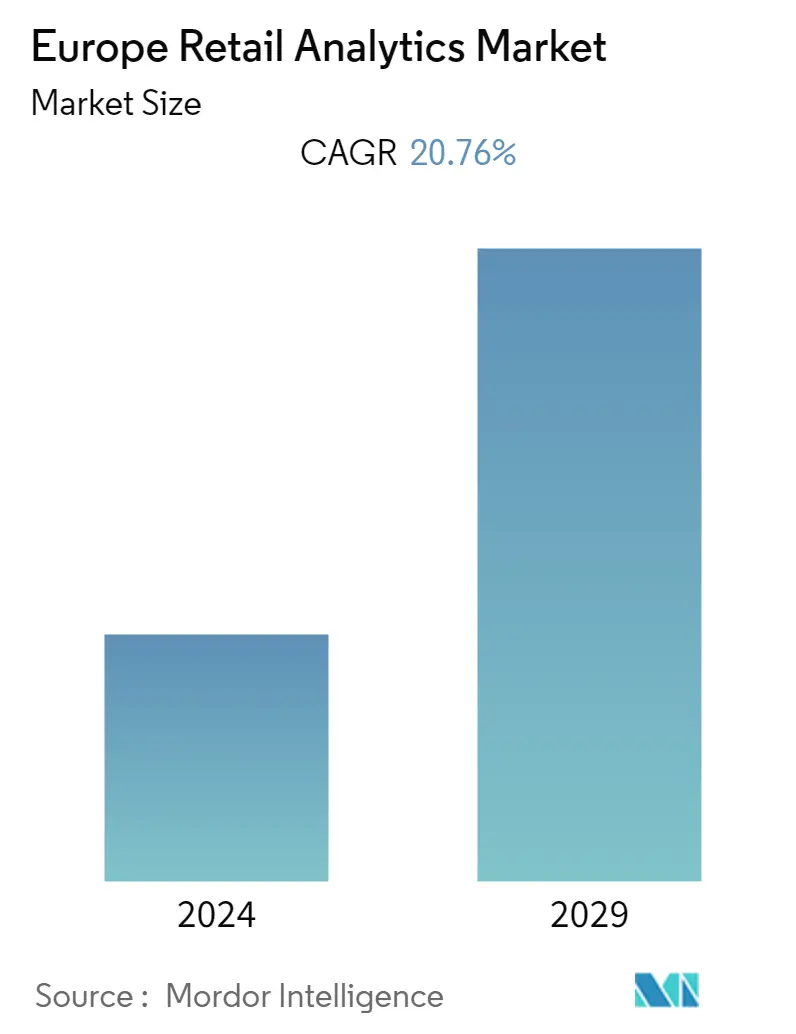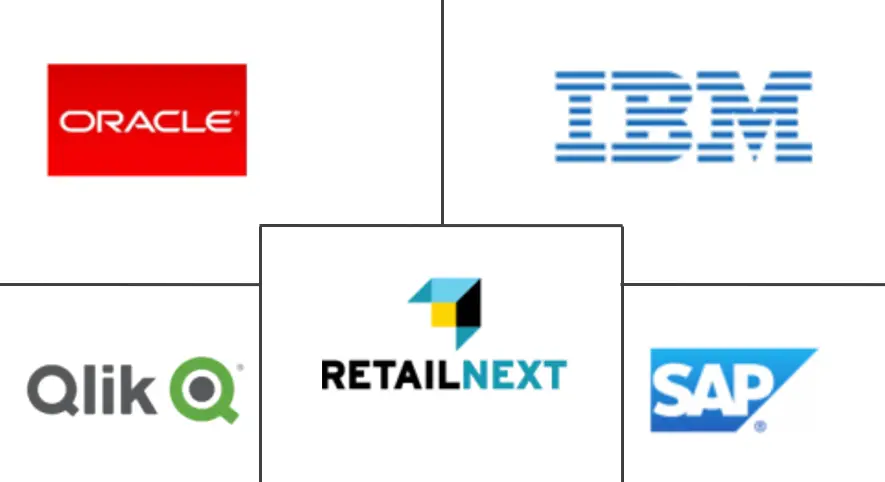Market Size of Europe Retail Analytics Industry

| Study Period | 2019 - 2029 |
| Base Year For Estimation | 2023 |
| Forecast Data Period | 2024 - 2029 |
| Historical Data Period | 2019 - 2022 |
| CAGR | 20.76 % |
| Market Concentration | Medium |
Major Players
*Disclaimer: Major Players sorted in no particular order |
Retail Analytics Market Analysis
The European retail analytics market is expected to grow at a CAGR of 20.76% during the forecast period. A sustained increase in expenditures in AI-based digital tools to address supply chain irregularities and retail shrinkage will give a huge potential for retail analytics providers. Europe also has many major retail brands and companies that support online presence, which is expected to encourage a lucrative demand for retail analytics in the region.
- The driving factor for using retail analytics in the region is that it provides tangible and practical insights into customer behavior. Retail analytics services are designed to give each consumer tailored attention. Companies have used data-driven retail analytics solutions that keep customers engaged with the company for a longer period in response to changing consumer needs and increasing rivalry among retailers for customer loyalty. Retail predictive analytics allows retailers to evaluate customer data and anticipate client wants and desires.
- Furthermore, from a customer-centric standpoint, implementing a retail analytics strategy is intended to offer businesses the resources and technology required to create and automate seamless consumer experiences across online channels. Customer experiences are improving as more retailers implement customer relationship management (CRM) systems. Furthermore, the increased use of IoT, POS, RFID and other smart devices generates enormous data, which merchants can utilize to find client buying preferences and hidden customer insights. As a result, retailers primarily focus on improving customer experience, which is expected to immediately drive demand for retail analytics services and software in the coming years.
- A retailer's primary resources are product inventory and shelf space allotment. It refers to the use of analytics to decide product offers in the right place, at the right time, and in the appropriate quantity for the right customers. In terms of micro-level analysis and assortment planning, this trend has now become a constant process in the retail industry. Shelf space management is being studied in relation to client preferences in the store and the financial impact of various assortments.
- For instance, Trax Ltd. and Roamler, two European startups, have joined forces to provide shop auditing services to consumer packaged goods (CPG) corporations. Companies constantly capture shelf photos and provide insights about shelf conditions. It improves product availability on the shelf and enables merchants to get timely insights and make decisions to improve shopper experiences.
- Business intelligence tools like decision support systems (DSS) have allowed companies in Europe to produce stress tests and sales forecasts, which are significantly used to assess a company's ability to operate under challenging economic scenarios. Utilizing DSS, companies can perform sensitivity analyses to evaluate the impacts of external variables, such as a possible lockdown or employee sickness, on their operations. Companies that favor data-driven decision-making are more expected to manage the crisis better and recover faster than businesses that do not use analytics and business intelligence.
Retail Analytics Industry Segmentation
Retail analytics provides analytics tools to the retail industry on business trends, patterns, and performance. Retail business analytics enable retailers to leverage data-driven insights from their businesses and customers to improve consumer experience, increase sales, and optimize business operations. The retail analysis provides important analytical data for marketing and procurement decisions, such as inventory levels, consumer demand, supply chain movements, and sales.
The Europe Retail Analytics Market is segmented By Mode of Deployment (On-Premise, On-Demand), Type (Solutions, Services), Module Type (Strategy & Planning, Marketing, Financial Management, Store Operations, Merchandising, Supply Chain Management), Business Type (Small & Medium Enterprises, Large-scale organizations), and Country (united kingdom, Germany, France, Others).
The market sizes and forecasts are provided in terms of value (USD million) for all the above segments.
| By Mode of Deployment | |
| On-Premise | |
| Cloud |
| By Type | |
| Solutions (Analytics, Visualization Tools, Data Management, etc.) | |
| Services (Integration, Support & Consulting) |
| By Module Type | |
| Strategy & Planning (Macro Trends, KPI, Value Analysis) | |
| Marketing (Pricing, Loyalty and Segment Analysis) | |
| Financial Management (Accounts Management) | |
| Store Operations (Fraud Detection, Workforce Analytics) | |
| Merchandising (Assortment Optimization, Shopper Path Analytics) | |
| Supply Chain Management (Inventory, Vendor and Supply-Demand Modelling) | |
| Other Module Types |
| By Business Type | |
| Small & Medium Enterprises | |
| Large-scale organizations |
| By Country | |
| United Kingdom | |
| Germany | |
| France | |
| Other Countries |
Europe Retail Analytics Market Size Summary
The European retail analytics market is poised for significant growth, driven by the increasing adoption of AI-based digital tools to tackle supply chain challenges and retail shrinkage. The region's robust presence of major retail brands and companies with a strong online footprint is expected to fuel demand for retail analytics solutions. These tools provide valuable insights into customer behavior, enabling retailers to offer personalized experiences and maintain customer engagement amidst rising competition. The integration of predictive analytics allows retailers to anticipate customer needs, enhancing the overall shopping experience. The proliferation of IoT, POS, and RFID technologies generates vast amounts of data, which retailers leverage to uncover consumer preferences and drive demand for analytics services.
The shift towards cloud-based analytics and business intelligence solutions is gaining momentum, offering retailers benefits such as 24/7 availability, scalability, and cost-effectiveness. Cloud solutions reduce the total cost of ownership and implementation time, making them more accessible and user-friendly compared to on-premise systems. This transition is expected to enhance data-driven decision-making, enabling retailers to respond swiftly to market changes and improve operational efficiency. In France, for instance, business intelligence tools like Microsoft's Power BI help retailers personalize customer interactions and optimize e-commerce strategies. The market is characterized by the presence of major players such as SAP SE, Oracle Corporation, and IBM Corporation, who are actively expanding their offerings through strategic partnerships and acquisitions, further propelling the growth of retail analytics in Europe.
Europe Retail Analytics Market Size - Table of Contents
-
1. MARKET DYNAMICS
-
1.1 Market Overview
-
1.2 Market Drivers
-
1.2.1 Increased Emphasis on Predictive Analysis
-
1.2.2 Sustained Increase in Volume of Data
-
1.2.3 Growing Demand for Sales Forecasting
-
-
1.3 Restraints
-
1.3.1 Lack of General Awareness and Expertise in Emerging Regions
-
1.3.2 Standardization and Integration Issues
-
-
1.4 Industry Value Chain Analysis
-
1.5 Industry Attractiveness - Porter's Five Forces Analysis
-
1.5.1 Threat of New Entrants
-
1.5.2 Bargaining Power of Buyers
-
1.5.3 Bargaining Power of Suppliers
-
1.5.4 Threat of Substitute Products
-
1.5.5 Intensity of Competitive Rivalry
-
-
-
2. MARKET SEGMENTATION
-
2.1 By Mode of Deployment
-
2.1.1 On-Premise
-
2.1.2 Cloud
-
-
2.2 By Type
-
2.2.1 Solutions (Analytics, Visualization Tools, Data Management, etc.)
-
2.2.2 Services (Integration, Support & Consulting)
-
-
2.3 By Module Type
-
2.3.1 Strategy & Planning (Macro Trends, KPI, Value Analysis)
-
2.3.2 Marketing (Pricing, Loyalty and Segment Analysis)
-
2.3.3 Financial Management (Accounts Management)
-
2.3.4 Store Operations (Fraud Detection, Workforce Analytics)
-
2.3.5 Merchandising (Assortment Optimization, Shopper Path Analytics)
-
2.3.6 Supply Chain Management (Inventory, Vendor and Supply-Demand Modelling)
-
2.3.7 Other Module Types
-
-
2.4 By Business Type
-
2.4.1 Small & Medium Enterprises
-
2.4.2 Large-scale organizations
-
-
2.5 By Country
-
2.5.1 United Kingdom
-
2.5.2 Germany
-
2.5.3 France
-
2.5.4 Other Countries
-
-
Europe Retail Analytics Market Size FAQs
What is the current Europe Retail Analytics Market size?
The Europe Retail Analytics Market is projected to register a CAGR of 20.76% during the forecast period (2024-2029)
Who are the key players in Europe Retail Analytics Market?
SAP SE, Oracle Corporation, Qlik Technologies, IBM Corporation and RetailNext, Inc are the major companies operating in the Europe Retail Analytics Market.

